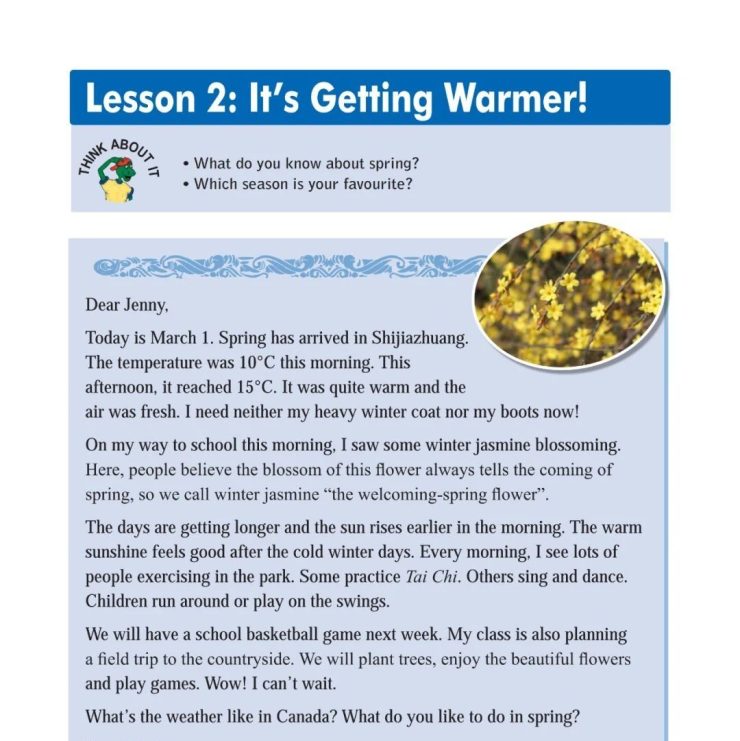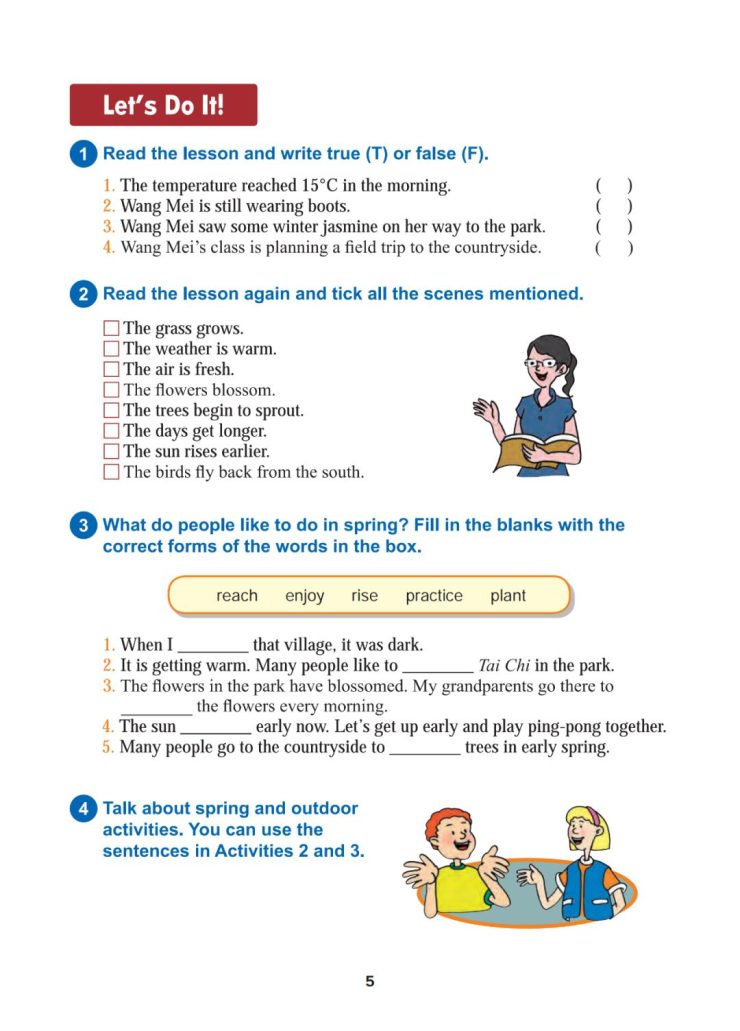冀教版初中英语八年级下册lesson2(附本课单词默读、课文朗读、课文翻译及重点句

冀教版初中英语八年级下册lesson2
01
单词朗读
1.neither /ˈnaɪðə; ˈniːðə/ 既不;也不;(两者)都不
2.nor /nɔː/ 也不;也没
3.boot /buːt/ 靴;靴子
4.jasmine /ˈdʒæzmɪn/ 茉莉
5.blossom /ˈblɒsəm/ 开花;花朵
6.sunshine /ˈsʌnʃaɪn/ 阳光
7.Tai Chi /ˌtaɪ tʃiː/ 太极
8.swing /swɪŋ/ 秋千;打秋千;摇摆
02
课文朗读

03
课文翻译
Lesson 2 It’s Getting Warmer!
第2课 天气变暖和了!
Dear Jenny,
亲爱的珍妮:
Today is March l.
今天是3月1日。
Spring has arrived in Shijiazhuang.
石家庄的春天已经来临了。
The temperature was l0℃ this morning.
今天早晨的温度是10℃。
This afternoon, it reached 15℃.
今天下午,温度达到了15℃。
It was quite warm and the air was fresh.
天气非常暖和,空气很清新。
I need neither my heavy winter coat nor my boots now!
现在我既不需要厚重的冬大衣也不需要我的靴子了。
On my way to school this morning,
今天早晨在我去上学的路上,
I saw some winter jasmine blossoming.
我看见了一些迎春花在盛开。
Here, people believe the blossom of this
flower always tells the coming of spring,
在这儿,人们认为这种花儿的盛开预示着春天的来临,
so we call winter jasmine “the welcoming-spring flower”.
所以我们把它称为“迎春花”。
The days are getting longer and the sun rises earlier in the morning.
白天变得更长,早晨太阳升起得更早。
The warm sunshine feels good after the
cold winter days.
寒冷的冬季过后,温暖的阳光让人感觉很舒服。
Every morning,I see lots of people exercising in the park.
每天早晨,我都看见许多人在公园里锻炼身体。
Some practice Tai Chi.Others sing and
dance.
一些人在打太极,一些人在唱歌跳舞。
Children run around or play on the swings.
孩子们到处跑,或者在荡秋千。
We will have a school basketball game next week.
我们下周将举行一场篮球比赛。
My class is also planning a field trip to the
countryside.
我们班还计划去郊区郊游。
We will plant trees,enjoy the beautiful
flowers and play games.
我们将植树、赏花、做游戏。
Wow! I can’t wait.
哇!我等不及了。
What’s the weather like in Canada?
加拿大的天气怎么样?
What do you like to do in spring?
你春天想做些什么?
Wang Mei
王梅
04
重点句 / Key points
石家庄的春天已经来临了。
arrive in“到达”,后面接大地方(如国家、城市),而arrive at”到达”,后面接小地方(如小镇、村庄、书店、医院等)。另外,get to“到达”,后面可以接任何地方,只不过,接home、there等词时,要将to省略。reach也意为“到达”,后面可以接任何地方,reach后直接接地点,千万别弄出reach to…的错误来。
Mr. Zhang arrived in Beijing yesterday afternoon.
=Mr. Zhang got to Beijing yesterday afternoon.
=Mr. Zhang reached Beijing yesterday afternoon.
张先生昨天下午到达了北京。
2.I need neither my heavy winter coat nor my boots now!
现在我既不需要厚重的冬大衣也不需要我的靴子了。
neither…nor… “既不……也不……”
“……和……都不”,,表示全部否定,
He is neither tall nor short.他既不高也不矮。注意:当neither…nor…连接两个主语时,讲究就近原则,也就是说,后面的谓语动词要和第二个主语保持一致,
1)Neither Jim nor I am from Canada.
我和Jim都不是来自加拿大。
2)Neither his parents nor he likes eating bananas.
他和他的父母都不喜欢吃香蕉。
3.On my way to school this morning
今天早晨在我去上学的路上
on one’s way to…“在去……的路上”,当后面接home时,务必将to省略,如:on his way home “在他回家的路上”,另外,短语中的one’s可以改为the。
4.I saw some winter jasmine blossoming.
我看见了一些迎春花在盛开。
see sb.doing sth.”看到某人在做某事”
We saw her chatting with her neighbors.
我们看到她在和邻居聊天。
也存在“see sb. do sth.”这一结构。
“see sb.doing sth.”与“see sb. do sth”的区别。
1)Look! Can you see Jim playing on the swing?
瞧!你能看到Jimg正在荡秋千吗?
2)I often see Jim play on the swing.
我经常看到Jim荡秋千。
5.Some practice Tai Chi.Others sing and dance.
一些人在打太极,一些人在唱歌跳舞。
some…others…“一些……(另)一些……”,
Some students are running,others are jumping一些学生在跑,一些(学生)在跳。
6.Children run around or play on the swings.
孩子们到处跑,或者在荡秋千。
run around “到处跑”。play on the swing(s)“荡秋千”,当然,swing一个词也可以作“荡秋千”讲
I like playing on the swing=I like swinging.
我喜欢荡秋千。
7.Wow! I can’t wait.
哇!我等不及了。
I can’t wait to do sth.我等不及要去做某事。I can’t wait for sth.我等不及……了。
8.形容词的比较级和最高级
1)在单词末尾直接加er或est,
long→longer(更长的)→longest(最长的);
warm→warmer(更暖和的)→warmest(最暖和的)
2)以字母e结尾的形容词,直接加r或st
nice→nicer(更好的)→nicest(最好的)
3)以“辅音字母+y”结尾的形容词,先把y变为i,再加er或est,
happy→happier(更快乐的)→happiest
·本课练习题·
本文链接: https://www.yizhekk.com/0146253020.html








